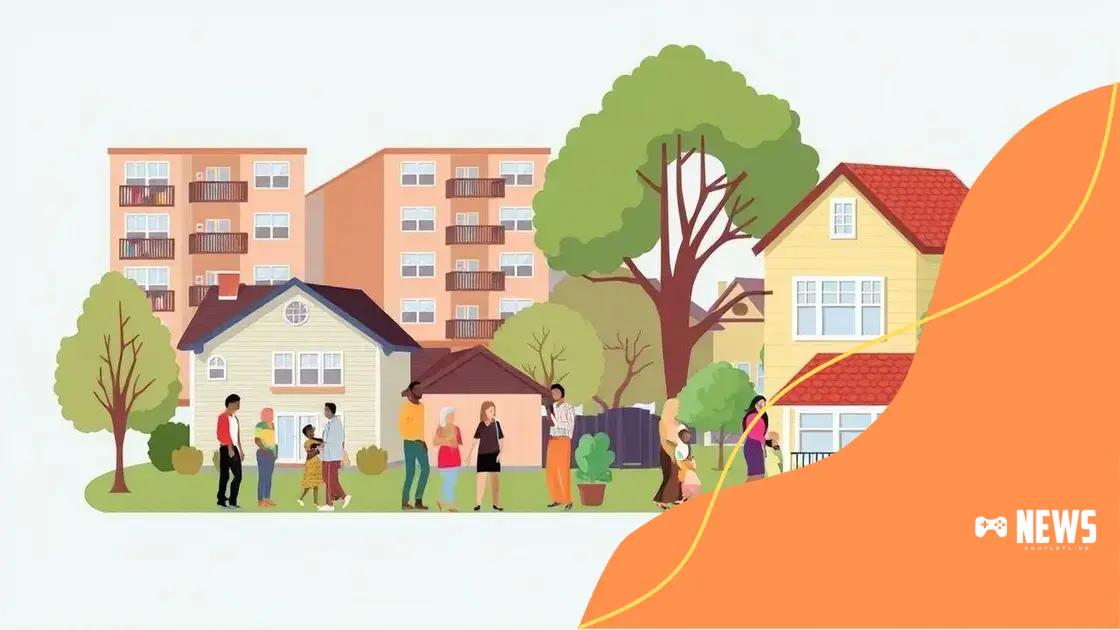Public housing assistance programs: understanding your options

Public housing assistance programs support low-income individuals by providing access to affordable housing options, including rental assistance, public housing, and vouchers to help secure stable living conditions.
Public housing assistance programs play a crucial role in helping individuals and families access affordable housing. Have you ever wondered how these programs can alleviate your housing concerns? In this article, we’ll delve into what they offer and how to make the most of available resources.
What are public housing assistance programs?
Public housing assistance programs are government initiatives designed to help low-income individuals and families access safe and affordable housing. Understanding these programs can empower you to find the support needed for your living situation.
These programs provide a variety of services that cater to different housing needs. For example, they may offer rental assistance, direct housing options, or help with finding adequate living conditions. The goal is to ensure everyone has a place to call home.
Types of public housing assistance programs
Programs vary widely in their structure and offerings, but they typically fall into a few key categories:
- Rental assistance: This type helps families pay a portion of their rent based on their income.
- Public housing: This option provides tenants with affordable apartments managed by housing authorities.
- Section 8 vouchers: These enable recipients to find suitable housing in the private market, expanding their options significantly.
- Homeless assistance programs: Focusing on those in immediate need, these programs aim to provide emergency shelters and long-term housing solutions.
Navigating these programs can be complex, but knowing what’s available is essential. Each program has specific eligibility requirements and application procedures. Thus, it’s important to gather necessary documents, such as proof of income and occupancy history, before applying.
Eligibility requirements for housing assistance
Eligibility for public housing assistance programs usually depends on several factors. Income limits are set based on local median income, and additional criteria may include family status, citizenship, and specific needs.
While applying, applicants should ensure their information is accurate and complete, as errors can delay processing. Additionally, some programs may prioritize certain groups, like veterans or disabled individuals, which influences eligibility chances.
Eligibility requirements for housing assistance
Determining your eligibility for housing assistance is a critical step in accessing these valuable programs. Various factors come into play, and understanding them can help you navigate the application process more efficiently.
Generally, eligibility is based on income, family size, and residency status. Most programs set limits on the maximum income a household can earn, ensuring that assistance goes to those who truly need it. Family size significantly affects these income limits; larger families usually have higher thresholds.
Income guidelines
Income eligibility is often defined as a percentage of the area’s median income (AMI). Here are the key points to keep in mind:
- Programs typically target families earning 30% to 80% of AMI.
- Your gross income is calculated, which includes wages, benefits, and any other sources of income.
- Depending on the program, some deductions might apply, allowing for a higher threshold based on specific expenses.
Understanding how income guidelines affect your eligibility can empower your application. Additionally, it’s important to keep documentation handy, as most programs require proof of income, such as pay stubs or tax returns.
Residency and family status
Residency status also plays a crucial role in determining your eligibility for public housing assistance programs. Applicants must be U.S. citizens or have eligible immigration status. This criterion ensures that government funds go to individuals who are legally residing in the country.
Family composition is another essential factor. Programs may prioritize households with children, elderly members, or individuals with disabilities. This focus helps allocate resources to those facing greater challenges in securing stable housing.
Ultimately, the eligibility criteria are designed to assist those in critical need. By fully understanding these requirements and preparing accordingly, you enhance your chances of successfully accessing housing assistance.
Types of public housing programs available

Understanding the different types of public housing programs available can help you find the best fit for your housing needs. These programs are designed to assist various populations, ensuring everyone has access to affordable living options.
Each program offers unique benefits and requirements. Here’s an overview of the most common types:
Public housing
Public housing consists of rental properties owned and managed by government entities. These housing units are aimed at low-income individuals and families. Residents typically pay a percentage of their income towards rent while the rest is subsidized by the government. This type of assistance helps keep housing costs manageable.
Section 8 housing
Another key type is Section 8 housing. This program provides housing vouchers to qualified individuals, allowing them to rent privately owned homes. The voucher pays a portion of the rent, making it easier for families to find suitable housing in their desired location. This flexibility is a major advantage for recipients.
Transitional housing programs
Transitional housing programs serve those facing homelessness or those in crisis. They offer temporary housing solutions with additional support services. This can include job training, counseling, and assistance with finding permanent housing. The goal is to help individuals regain stability and self-sufficiency.
Supportive housing
Supportive housing is another critical type of program aimed at specific populations, such as individuals with disabilities or the elderly. It combines affordable housing with on-site services like healthcare, job support, and life skills training. This type of housing ensures residents receive the help they need to thrive.
By understanding these different public housing programs, you can make informed decisions about your housing options. Each program serves a unique purpose and can be a vital resource for those in need of assistance.
Applying for housing assistance: step-by-step guide
Applying for housing assistance can seem overwhelming, but breaking it down into manageable steps makes the process easier. Understanding the requirements and procedures is key to success.
The first step usually involves determining your eligibility for various programs. You should gather important documents like proof of income, identification, and any previous housing records. Make sure all information is up-to-date and accurate, as this will help expedite your application.
Step 1: Research available programs
Begin by researching different public housing assistance programs in your area. Each program may have its own eligibility criteria and application requirements. Look for local housing authorities or community organizations that provide resources and assistance. Knowing what programs are available lets you make informed choices.
Step 2: Complete the application form
Once you identify the right program, it’s time to fill out the application form. Most applications can be done online or via paper forms. Be sure to answer all questions honestly and completely. Incomplete applications may lead to delays or denials.
- Ensure you include all required documentation.
- Double-check for any errors before submission.
- Keep a copy of your application for your records.
After submitting your application, follow up with the housing authority. This shows your commitment and helps resolve any potential issues quickly.
Step 3: Attend any necessary interviews
Some programs may require an interview as part of the application process. Be prepared to discuss your financial situation and living conditions. Bring any additional documentation that may be requested. This is your chance to ask questions and clarify any aspects of the program.
Step 4: Wait for approval
After you complete your application and interview, the waiting process begins. It can take time for the housing authority to review your application and make a decision. During this period, stay in contact with them, and be ready to provide any further information if required.
By following this step-by-step guide, you can navigate the application process for housing assistance with more confidence. Being organized and proactive leads to higher chances of receiving the support you need.
Tips for navigating public housing applications
Navigating public housing applications can be a tricky process, but following some helpful tips can make your experience smoother and increase your chances of approval. Being well-prepared is key to success.
Start by familiarizing yourself with the specific requirements of the program for which you are applying. Each program may have different rules, so understanding these differences can save you time and effort. Keep a checklist of all the required documents like income statements, identification, and rental history, to streamline your application process.
Organize your documents
Having your information ready is vital. Organize your documents by categories such as:
- Income verification: This could include pay stubs, tax returns, or bank statements.
- Identification: Have copies of your ID or social security number.
- Rental history: Collect records of past addresses and landlord contacts.
Proper organization allows you to quickly access needed information when filling out forms or attending interviews.
Follow deadlines
Pay attention to application deadlines, as missing them can delay your assistance or disqualify you from the program. Mark important dates on your calendar and set reminders. Some agencies offer waiting lists, but spots can fill up quickly, so applying early is a smart strategy.
Stay in contact
Once you submit your application, keep in touch with the housing authority. Make sure to follow up on your application status. This shows your interest and commitment. If they require additional information or documentation, respond promptly to avoid any delays.
If there are any changes in your circumstances, such as a job change or an increase in family size, inform the housing authority as soon as possible. Keeping them updated ensures your application remains accurate and relevant.
Lastly, applying for public housing assistance can be daunting, but remaining organized and informed is vital. Following these tips can help you navigate the application process with confidence.
FAQ – Frequently Asked Questions about Public Housing Assistance
What is public housing assistance?
Public housing assistance provides support to low-income individuals and families, helping them access affordable housing options.
How do I apply for housing assistance?
To apply, gather required documents, research available programs, and complete the application form while meeting deadlines.
What types of assistance can I receive?
You can receive rental assistance, public housing options, Section 8 vouchers, and transitional housing support, depending on eligibility.
How can I increase my chances of getting approved?
Stay organized, follow up with housing authorities, keep your information accurate, and be proactive in your communication.





